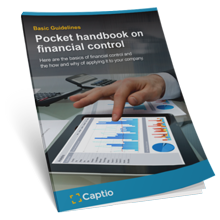Any financial performance process becomes meaningless if a strategy to control it is not defined and implemented based on objectives consistent with the current state of the company and its upcoming projects.
Financial control has now become an essential part of any company's finances. Hence, it is very important to understand the meaning of financial control, its objectives and benefits, and the steps that must be taken if it is to be implement correctly.
Definition of financial control
Financial control may be construed as the analysis of a company's actual results, approached from different perspectives at different times, compared to its short, medium and long-term objectives and business plans.
These analyses require control and adjustment processes to ensure that business plans are being followed and that they can be amended in the event of anomalies, irregularities or unforeseen changes.

>> Do you want to be able to design an effective financial control system for your company? Discover how do it in this free pocket handbook <<
Objectives and benefits
1. CHECKING THAT EVERYTHING IS RUNNING ON THE RIGHT LINES
Sometimes, financial control just checks that everything is running well and that the levels set and objectives proposed at the financial level regarding sales, earnings, surpluses, etc., are being met without any significant alterations. The company thus becomes more secure and confident, its operating standards and decision-making processes being stronger.
2. DETECTING ERRORS OR AREAS FOR IMPROVEMENT
An irregularity in the company finances may jeopardize the achievement of an organization's general goals, causing it to lose ground to its competitors and in some cases compromising its very survival. Therefore, it is important to detect irregularities quickly.
Various areas and circuits may also be identified which while not afflicted by serious flaws or anomalies could be improved for the general good of the company.
3. OTHER USES
Financial control may also serve to:
Implement preventive measures. Occasionally, early diagnosis of specific problems detected by financial control makes corrective actions unnecessary, as they are replaced by solely preventive actions.
Communicate with and motivate employees. Precise knowledge of the state of the company, including its problems, mistakes and those aspects which are being handled correctly, encourages better communication with employees and motivates them to ensure that they follow the correct line or improve the necessary aspects.
Take action where required. Detecting the situation is of little use without concrete actions to get a negative situation back on track thanks to specific and detailed information provided by finance control.

Implementation strategies
Financial control must be designed on the basis of very well defined strategies if the directors of the companies are to be able to:
-
Detect anomalies in budgets, balance sheets and other financial aspects.
-
Establish different operational scenarios putting profitability, sales volume and other parameters to the test.
Although there are many different types and methodologies, a very common set of steps can be distinguished in the vast majority of financial control implementation strategies.
STEP 1. ANALYSIS OF THE INITIAL SITUATION
The first step is to conduct an exhaustive, reliable and detailed analysis of the company’s situation across various areas: cash, profitability, sales, etc.
STEP 2. PREPARATION OF FORECASTS AND SIMULATIONS
On the basis of the initial situation analyzed above and the establishment of a set of parameters or indicators, a set of forecasts and simulations of different contexts and scenarios can be prepared.
These simulations are immeasurably helpful in making appropriate decisions on such crucial aspects as investments, profitability, changes in production systems, etc.
THE ESTABLISHMENT OF PARAMETERS OR INDICATORS IS ESSENTIAL TO DELIMITING EXACTLY WHAT WE WANT TO CONTROL. THEY INCLUDE BASIC FUNCTIONS AND KEY AREAS OF THE MARKET, THE MOST COMMON OF WHICH ARE: RETURN ON EARNINGS, TAX SITUATION, STATE OF INVESTMENTS, ASSETS, LIABILITIES, EQUITY, PROFIT AND LOSS
STEP 3. DETECTION OF DEVIATIONS IN THE BASIC FINANCIAL STATEMENTS
The basic financial statements are the documents which must be created by the company in preparing the annual accounts. The three most important documents are the general balance sheet, the profit and loss account and the cash flow statement.
These analyses and tests in different environments are a fundamental part of financial control, since they permit problems, errors and deviations from the ideal situation or initial objectives to be detected early.
STEP 4. CORRECTION OF DEVIATIONS
Financial control would have very little practical use if the proper decisions relating to corrective actions were not taken to get the company accounts on the right track as previously established in the organization’s general objectives.





